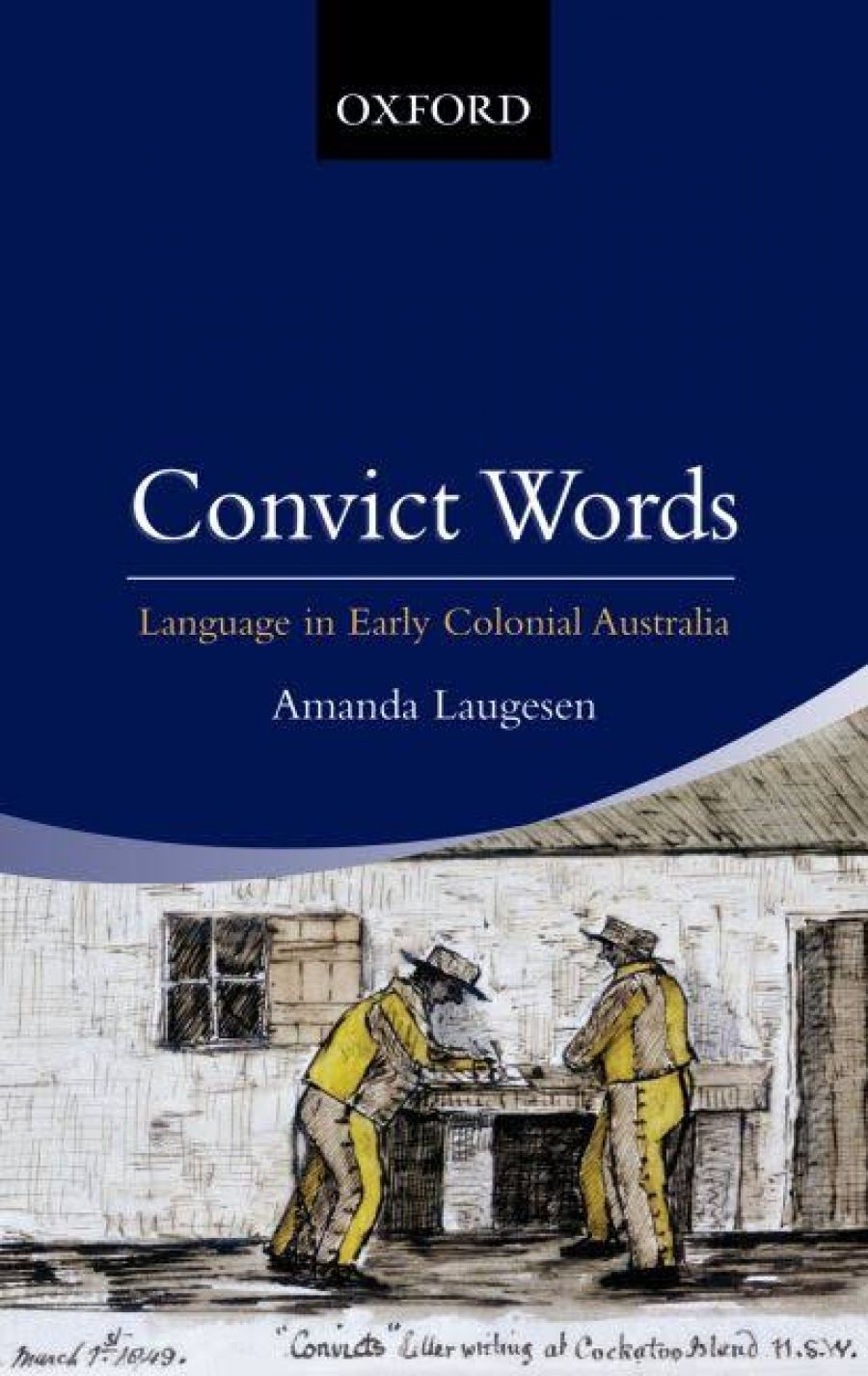
- Free Article: No
- Contents Category: Australian History
- Review Article: Yes
- Online Only: No
- Custom Highlight Text:
Amanda Laugesen’s Convict Words is a dictionary of the characteristic or salient words of early colonial discourse, the lexis of the convict system and transportation, which survived until 1840 in New South Wales, 1852 in Van Diemen’s Land, and 1868 in Western Australia. It is not immediately clear what sort of readership is envisaged for the book. It would not occur to many people interested in Australian colonial history to address the subject through the words the actors in that history used, and the book does not directly answer most of the questions the enquirer might have in mind, unless of course it were convictism itself. As for word-buffs, the limited range of the target lexis – convict words in this narrow sense, and not necessarily Australianisms – may not have suggested itself as an engrossing topic.
- Book 1 Title: Convict Words
- Book 1 Subtitle: Language in early colonial Australia
- Book 1 Biblio: OUP, $34.95 pb, 232 pp
Well, logophiles and armchair penologists (half of the talk-back radio audience, it often seems) will doubtless be intrigued or pleased to learn that the terms life and lifer, hard labour and probation are all of Australian origin. In 1839 probation replaced the assignment system whereby convicts were assigned or made over into the service of a private individual who had to feed and clothe, but not pay, his convict servant. By the 1830s the colony was in any case divided into two separate camps, transportationists and anti-transportationists. In the later 1840s those opposed to convictism took to blackguarding its supporters as pollutionists, the most wonderful word in Convict Words.
Reading the book, one is soon immersed in divisions of other sorts, too: the intricacies of a class-ridden society that pitted free emigrants or settlers against emancipists, expirees, and ticket-of-leave men, and those two classes against the convicts. It rankled with the free and the freed that the police constables were often convicts, ‘doubly convicted felons … walking into free men’s houses with all the freedom and insolence possible’.
Yet the sardonic, levelling humour that Australians still like to think their own was born of the convicts who, for instance, ironically appropriated the name legitimate for themselves. ‘Next we have the legitimates, or cross-breds, namely, such as have legal reasons for their visiting the colony; and the illegitimates, or such as are free of that stigma,’ wrote Peter Cunningham, a naval surgeon, in 1827, describing the colony’s divisions.
Free was in fact a profoundly ambiguous word at the time, and the ambiguity encapsulates the colony’s divisions. A free settler could, in colonial usage, be an ex-convict, emancipist settler, for free could also mean ‘freed’. On the other hand, in a society founded on convictism, great efforts were made to avoid the word convict. Governor Macquarie preferred prisoner as being less harsh, and others spoke of assigned servants and even, with studied evasiveness, servant of the crown, government man, and settler’s man. I have to report that public servant was also first used to mean ‘convict’. Plus ça change, the more jaundiced of us might think.
Of course, many emancipists and conditionally pardoned did very well for themselves, to the chagrin of the illegitimates, who thought it was too easy for the tainted to thrive and get on. Macquarie, who now enjoys a high reputation for his forward-looking and enlightened policies, was then widely regarded as unduly favouring convicts and emancipists at the expense of the free settlers who successfully worked to have him recalled. He was dead within a year or two, a broken man. The resentment grew stronger after Macquarie’s day, and led to sarcastic terms like Botany Bay aristocracy:
A man is not responsible for the faults or crimes of his relatives or progenitors, but when we find ‘The Block’ thronged with this Botany Bay aristocracy, whose insufferable pretentions would be unbearable in the bluest blood to be found in ‘Debrett’, one cannot help reminding these gaudy tulips that they spring from very dirty roots.
It will have been noted that the title does not mean what it might most obviously be taken to mean: convict words or the jargon or cant of convicts and of the underworld generally. In her introduction, Amanda Laugesen claims that ‘the language of convicts remains fairly hard to find’, even though just twenty-four years after the foundation of the colony an already twice-transported convict, James Hardy Vaux, compiled a copious glossary of flash, or underworld slang, which remains one of the key documents in the history of criminal lexicography. She chooses to treat just eleven of Vaux’s flash terms. Why? Using Vaux and R. Langker’s useful monograph, Flash in New South Wales 1788–1850, published in 1980 by the Australian Language Research Centre at the University of Sydney, it would not have been hard to treat this aspect of the lexis, which many readers will be disappointed to find has been so scanted. Curiously, some non-flash words that occur in the quotations are not treated either, including illegitimates and cross-breds in the Cunningham quote above, and the word tainted I used earlier.
The book’s strength lies in Laugesen’s commentary, which adeptly contextualises the words, and the quotations selected to illustrate the words. The citations are longer than those usually furnished in historical dictionaries such as the Australian National Dictionary, of which this book is largely an offshoot. This greater space allows them to make some point or other, beyond the initial and primary task of illustrating the word. Despite my misgivings, Convict Words in the main achieves what it set out to do with skill and care, and provides instruction and amusement along the way.


Comments powered by CComment